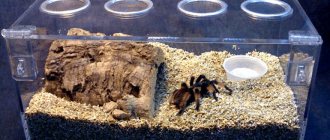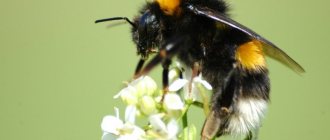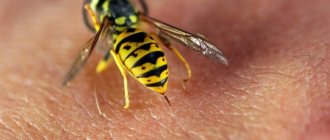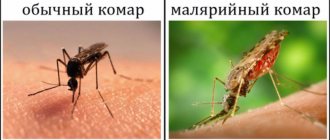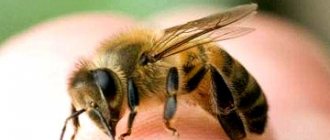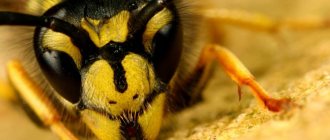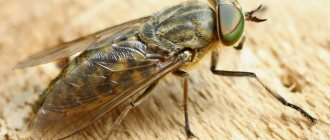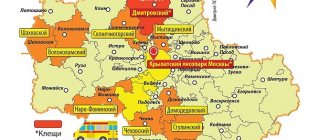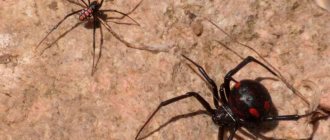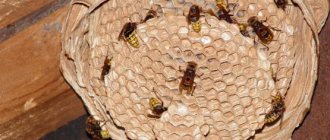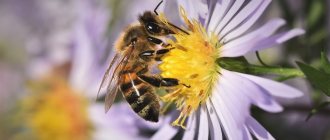There are several species of spiders in Russia, the bite of which can pose a serious danger to human life and health.
Karakurt
The Karakurt can be recognized by its black color with red spots and an hourglass pattern on the underside of the belly. This bright warning color indicates danger. The Karakurt mainly lives in southern Russia, but can migrate in extreme heat.
– After a bite, a person feels a burning pain throughout the body, swelling and redness occur at the site of the bite. Symptoms such as headache, rapid heartbeat, increased sweating, muscle spasms, heaviness in the chest, convulsions and tremors are possible, lists surgeon Ilya Efremov .
Karakurt. Photo: Globallookpress
South Russian tarantula
The South Russian tarantula (or mizgir) is a fairly large spider (females reach 30 mm, males 25 mm), whose body is covered with thick hairs. The color of the spider is brownish-red above, almost black below. The spider prefers a dry climate, but recently it is found almost throughout Russia.
– The bite of the South Russian tarantula is very painful. After a bite, dizziness, low blood pressure, heart rhythm disturbances, and numbness of the limbs develop. Allergy sufferers experience a sharp increase in temperature, sore throat, Quincke's edema, and anaphylactic shock, says Dr. Efremov.
South Russian tarantula. Photo: Commons.wikimedia
Cross
The cross spider got its name because of its peculiar color: on the back of the spider there are white or light brown spots resembling a cross. Crosses usually settle near bodies of water, in forests and parks. In the crowns of trees and between branches, spiders make webs from cobwebs and wait for hours nearby for prey.
– The bite of the cross is not dangerous to humans. At most, weakness may appear for 1 - 2 days and redness with swelling at the site of the bite, says surgeon Ilya Efremov.
Cross. Photo: Globallookpress
Yellow sak
The yellow sak lives in steppes and meadows and has the color of scorched grass, as well as huge chelicerae (claw-shaped mouthparts). The yellow sak is quite aggressive, so you should not get too close to it. Previously, yellow sakis mostly lived in the southern regions, but now they are found in large numbers in the middle zone and in the north of Russia.
– A yellowjacket bite can cause a severe allergic reaction, with severe swelling, headaches, weakness, vomiting and nausea. Saka poison will not lead to death, but can be quite dangerous for allergy sufferers and children, explains Dr. Efremov.
Yellow sak. Photo: Globallookpress
Black fathead
The black fathead (or black eresus) looks very elegant and unusual. The top of its red or dark orange body is decorated with black dots. True, only males can boast of such a colorful appearance; females are usually inconspicuous. They prefer meadows and steppes, where they settle in deep burrows.
– The bite of these spiders is very painful, the affected area loses sensitivity. Symptoms: malaise and stiffness in movement for 2 - 6 days, lists surgeon Efremov.
Black fathead. Photo: Globallookpress
What does a spider bite look like?
All representatives of spiders have poisonous glands. The toxic substance is necessary to immobilize the victim and liquefy the insides. In some spiders, the dose of poison is enough to kill fruit flies and mosquitoes, while others paralyze rodents and amphibians. The latter are usually called poisonous; it is their bites that can be fatal for a person.
Spiders bite with special fangs called chelicerae. They are located in the front part of the cephalothorax and have different shapes. The strength of the power is different for all predators. Some barely bite through the skin, others pierce the “tusks” to the very base. Bites differ in the severity of pain - an immediate burning pain or discomfort appears after some time.
On a note!
Spiders do not attack people on purpose; they bite to protect their own lives. Most bites occur due to a person’s carelessness, when he does not notice the predator, or out of excessive curiosity, as well as due to improper handling of an exotic pet.
How a spider bites, external symptoms:
- the presence of two wounds located in close proximity, or a continuous inflamed spot;
- swelling;
- redness;
- edema;
- blisters on the skin filled with fluid inside around the inflamed area;
- After a few days, suppuration may appear.
Externally, spider bites often resemble the bites of bees, wasps, hornets, and sometimes mosquitoes. It all depends on what species carried out the attack. A photo of a spider bite on a person is located below.
Spider bite
The entry of pathogenic microorganisms into an open wound leads to severe inflammation, swelling, increased redness, suppuration, the appearance of ulcers, and weeping eczema. Photos of skin lesions of secondary infection can be seen below.
Karakurts of Kazakhstan: how to escape from a fatal bite?
Last time we talked about Scorpios. But, as usual, any conversation between experienced Kazakhstanis about scorpions smoothly moves on to phalanges (we also talked about them - “Truth, about the most terrible spider in Kazakhstan”), flows to tarantulas and ends with karakurts. Among the four “deadly octopuses” living in our republic, the karakurt is without competition. And many scary stories about its terrible poison, alas, have a basis. By its nature, this cowardly and inconspicuous spider is a true fiend of the arachnid race. Although many legends, absurdities and inaccuracies have accumulated around it.
Let’s try to imagine a portrait of the “Black Death”, because to recognize an adversary means to gain advantages in confrontation with him.
Karakurt is very poisonous. However, all spiders are poisonous. Another thing is that not every one of them can bite through human skin and their toxicity is abstract for us. Karakurt - bites through.
The poison of the karakurt is 15 times stronger than that of the famous rattlesnake. But this is for tropical representatives. In our black karakurt Latrodectus mactans tredecimguttatus it is somewhat weaker. But not by much. So even that insignificant amount that the tiny poisonous glands of a small spider can produce can lead to big troubles. Moreover, during a bite, the poison is injected from the hollow claw, which ends the chelicerae (upper jaws) of the spider, as if from a syringe under the pressure of a powerful muscular membrane.
A bite from an undetected creature is always sudden, but the same cannot be said about the consequences. Here is a picture of a typical poisoning, taken from the reference book “Poisonous Plants and Animals of the USSR”:
“At the moment of a bite, an immediate burning pain is most often felt, spreading throughout the body within 15-30 minutes. Typically, patients complain of unbearable pain in the abdomen, lower back, and chest. Characteristic sharp tension in the abdominal muscles. Symptoms of general poisoning include: shortness of breath, palpitations, increased heart rate, dizziness, headache, tremor, vomiting or facial flushing, sweating, a feeling of heaviness in the thoracic and epigastric regions, exophthalmos and mydriasis. Priapism, bronchospasm, urinary and defecatory retention are also characteristic. Psychomotor agitation in the later stages of poisoning is replaced by deep depression, blackouts, and delirium. Fatalities have been reported in humans and farm animals.”
If the process proceeds according to an optimistic scenario, then the first signs of improvement begin after 3-5 days. After 2-3 weeks recovery occurs. But weakness is felt for a month.
If the scenario is fatal, then in the absence of medical care, death occurs the very next day after the bite.
But the most dangerous thing for a person in karakurt is not poison,
and its inconspicuousness and omnipresence. This tiny and light spider, although a classic inhabitant of clay deserts and steppes, is very widespread and common throughout almost all of Kazakhstan. It lives on the ground, in other people's burrows, but is often not only blown away by gusts of wind, but also transported through the air over considerable distances. So it’s easy to end up in places where they weren’t expecting him at all and didn’t expect to find him: in yurts, tents, shepherds’ houses, dekhan huts, bedrooms, toilets, storerooms, cellars.
Contrary to expectations, the karakurt does not attack the first person it comes across. In general, he is not one of the desperate daredevils. However, if accidentally touched or accidentally crushed, it stings without hesitation.
What to do if you are bitten by a karakurt?
Dr. F.F. Talyzin, the author of the fascinating book “Poisonous Animals of Land and Sea,” gives the following recommendations (some of them, however, seem very problematic to implement over time - Fyodor Fedorovich wrote in Soviet times):
“The most effective remedy is anti-karakurt serum, produced by the Tashkent Bacteriological Institute. After intramuscular injection of 30-40 cm3 of serum, the suffering quickly subsides, and after 3-4 days the patient recovers... Drinking plenty of fluids, warming the patient’s limbs and body with heating pads during chills, trembling, a feeling of cold, and significant muscle tension will have a good effect.”
The authors of the above reference book add:
“Intravenous administration of novocaine, calcium chloride and magnesium hydrogen sulfate also gives good results. In any case, it is necessary to ensure the provision of medical care.”
What if there is no help nearby?
When biting, you can burn this area with the head of a flammable match, since the spider bites through the skin with its chelicerae to a depth of only 0.5 mm. But this must be done no later than 2-3 minutes after the bite.
The last recipe is based on the know-how of our inspired professor P.I. Marikovsky. They say that to prove the effectiveness of his method, Marikovsky conducted experiments. Experiments on myself - I put my hand under the bite of a karakurt, and then struck a match. Agree, this is an act worthy of a classic of natural science!
And one more “outsider’s advice” – keep your cool. Fear is a deadly factor in itself. After all, even if you are bitten by a karakurt, you still have a good chance of staying alive. Let the example of seven-month-old Almaty resident Zhenya Stupyakov live in our memory:
“In the summer of 1969, a 7-month-old child, Zhenya Stupyakov, was admitted to the intensive care unit of the 11th Clinical Hospital of Almaty. The grandmother shook off the female poisonous karakurt spider from her grandson after it had bitten him. The doctors did everything to save the victim. In practice, there was little chance of salvation, but the administration of serum, blood transfusion and other urgent measures ended in victory for the doctors. After 10 days, the boy was discharged from the hospital in good condition.”
In conclusion, I would like to cite a couple of interesting facts from the life of my today’s not very nice hero (and the unpleasant neighbor of all Kazakhstanis who walk the earth).
Probably, few of the readers know that not a single person died from a karakurt bite!
All victims were accounted for by female karakurt. As for the male, he is an unhappy and downtrodden creature, inferior to his partners in everything: size, poisonousness, aggression, cunning. The destiny of a karakurt man is only love. Sacrificial, with an invariable fatal outcome.
This is how the source describes the typical fate of a male karakurt:
“The male is small and leads a vegetarian lifestyle... Next to the female’s snares, he weaves small “mating nets”, into which he lures the female with rhythmic movements of his legs. Mating takes place in the female’s burrow, after which the male tries to quickly disappear outside the den, but the female spits cobwebs after him and glues her legs together, after which she eats her spouse.”
And one moment. The poison of the karakurt (karakurtikhi) has a very selective effect on victims. Thus, horses and camels that receive bites on the lips while grazing die very often. But for locusts and fillies, which are the usual food of karakurts, this poison does not work as quickly as it does for spiders, which most of us have never heard of. That is, the karakurt poison is more aggressive towards mammals than towards insects. Why?
Here is how Pavel Justinovich Marikovsky explains the reason for the apparent nonsense:
“Karakurt poison has a weak effect on insects, but is fatal for many mammals... Karakurt
-
the original inhabitant of the loess desert, where almost the only shelter from the sun's heat and dryness are rodent burrows.
Clearly avoids the sandy desert. In the struggle for burrows, the karakurt acquired its toxicity towards their owners - rodents. But a new quality has developed due to the weakening of the toxicity towards its own prey - insects. The first turned out to be more important than the second. Why does poison, if it is destructive for rodents living in burrows, affect humans? Rodents are, to a certain extent, related to humans...” Well, we have lived to see that we, the proud kings of nature, have been likened to hamsters and gophers!
I wonder what a famous zoologist would answer to the question about hedgehogs, who are not only not afraid, but also willingly eat karakurts for dessert?
Spider bite - symptoms in humans
The development of general symptoms depends on how the spider bites, what species it is, and how much poison it injects. In most cases, people get away with discomfort and painful sensations on the skin, and some of the victims do not notice anything at all; the bite goes away on its own.
The strength of the immune system and the individual characteristics of the body play a huge role. However, in the event of a poisonous spider bite, even the strongest defensive reaction may not work. The effect of a toxic substance depends on qualitative and quantitative indicators. The spider bites once and rarely attacks again. After the first attack, he tries to quickly hide in a secluded place. The poison enters the bloodstream and spreads throughout the body; what the consequences will be depends on the quality indicators and the mechanism of action of the toxic substance.
- Neurotoxic poison affects the functioning of the central nervous system and peripheral. It provokes muscle spasms, which disrupts the functioning of internal organs - heart, lungs, stomach, brain, etc.
- The spider's hemolytic venom destroys red blood cells, leading to changes in the composition and quality of the blood. The bite can cause internal bleeding.
Spiders in Russia are the owners of a neurotoxic substance. The consequences depend on the composition of the poison. With a potent substance, deterioration in well-being is observed within 15 minutes after the incident.
- weakness;
- headache;
- dizziness;
- loss of consciousness;
- nausea;
- vomit;
- diarrhea;
- difficulty breathing;
- swelling of the larynx;
- shortness of breath, lack of oxygen;
- tremor of the limbs;
- muscle pain;
- profuse sweating;
- violation of movement coordination;
- cardiopalmus;
- increased blood pressure, body temperature;
- pale skin;
- slowing heart rate.
Consequences of a bite
Without timely medical care, a person may die from suffocation or cardiac arrest.
On a note!
The consequences of a spider bite are always more pronounced in children, the elderly, and people with reduced or pathologically weak immunity. In this case, even the bite of an ordinary cross can threaten a person’s life.
Why is a spider bite dangerous?
All spiders are poisonous to one degree or another, but their danger to humans is determined by two factors: the properties of the toxic substance and the power of the bite. Venom glands are located on the mouth appendages, and the main purpose of the toxic substance is to paralyze and then digest the victim.
Non-hazardous to humans include very small individuals that are unable to bite through human skin. Their poison is only suitable for paralyzing midges caught in the web. However, allergy sufferers should not relax, because even the most harmless house spider can cause a severe allergic reaction, swelling of the larynx, and suffocation.
The bite of a poisonous spider, especially a large one, even a physically healthy person, can lead to tragic consequences. Easily biting through the victim's skin and generously releasing poison, the silent killer attacks the vital systems of the body. In addition to allergic rashes, the victim experiences a general deterioration in health; cardiac arrest and suffocation may occur.
What spiders bite
Experts say that spiders that live in Russia do not attack themselves and do not rush to attack a person. They do not have an aggressive disposition; they prefer to quickly hide in a secluded place without unnecessary incidents. If the situation develops in such a way that the predator feels a threat to its own life, it bites and injects poison. Absolutely all arachnids bite, but the consequences are different.
You can meet a predator at home. In the warm season, spiders settle in residential buildings and apartments, entering through open windows, doors, and cracks in the wall. Small spiders hide in corners and behind furniture during the day, and at night they are active - they spin webs. A house spider bite is a rare occurrence and not dangerous. Small children under 1 year of age who show excessive curiosity and are left without parental supervision suffer. House spiders are dangerous only for people suffering from arachnophobia.
The most dangerous species of arachnids in Russia live in the wild, but in search of food, in the process of migration, they can end up in the possessions of a person, his home. Often predators bite people in nature, after they have quietly climbed into things, shoes, and clothes. They bite unnoticeably.
Why does a spider bite
Contrary to what many people think, spiders are not characterized by unmotivated aggressive behavior. Sensing danger, predators with a developed instinct of self-preservation try to run away and hide. Only if they can’t escape do they save their lives.
As a rule, the culprit of the attack is the person himself, accidentally or intentionally threatening the life of the arthropod: trying to kill it, finding it on his clothes/skin, disturbing its habitat, and so on. It is important to understand that spiders sense a threat on a biological level and defend themselves as best they can.
Dangerous spiders in our area
Due to global warming and dry summers, there is a migration of southern individuals to the northern regions. In Russia, poisonous creatures have become common, the bite of which leads to death if timely medical care is not provided.
Karakurt
The most dangerous spider in our area. The bite of a poisonous spider provokes instant pain, a local allergic reaction, and after 15 minutes the general symptoms of poisoning described in the section above develop.
Medium sized predator. The female reaches 2 cm, males - 70 mm. Long black legs, 13 red spots on the abdomen. With age, the color becomes more uniform, the spots disappear. Karakurts live in arid places and build burrows underground.
Karakurt and tarantula
South Russian tarantula
The most common poisonous specimen in our area. A bite on a person’s skin causes an immediate allergy, and after 20 minutes a deterioration in well-being is observed. If timely medical care is not provided, death may occur. Tarantulas are the most dangerous for children.
The size of the female, together with the leg span, reaches 35 mm; males are half that size. Color: beige, brown, white with dark streaks.
On a note!
A distinctive feature of the poisonous South Russian tarantula is its dark head. The limbs are long, powerful, the whole body is covered with hairs.
Sak
An exotic, bright creature with a memorable appearance. Other names: heyracantium, yellow. The predator is a medium-sized sak, the female is about 1 cm, the males are even smaller. The legs and abdomen are amber-yellow, the cephalothorax is red or orange.
On a note!
Powerful jaws, chelicerae in the form of curved fangs. Quietly bites through a person's nail plate.
The animal is timid and does not have an aggressive disposition; if a yellow sak bites, this means that it had to defend its own life. An instant, burning pain appears, followed by redness and swelling. After a bite, children, people with weak immunity, and a tendency to allergies develop weakness, malaise, and symptoms of intoxication. Medical attention required.
Black fathead
A bite with an allergic reaction of varying degrees of intensity is dangerous. It is classified as poisonous. Marks on the skin disappear within 2 weeks. General malaise is present for the first few days. If a severe allergic reaction occurs, medical attention is required. A red spider bite does not lead to death.
Males have a bright color - the legs and cephalothorax are black, velvety, the abdomen is red with four black spots. Females are larger in size - 1 cm, the whole body is black.
Spiders whose bites are dangerous
Black widow, false black widow
It is the most poisonous creature on earth. Black widows belong to the karakurt family.
Important!
The poison is 15 times stronger than the bite of a rattlesnake. Life-threatening symptoms develop within 15 minutes. The introduction of a special substance is required to neutralize the poison. If a child is bitten by a spider, death can occur within half an hour.
The false black widow is slightly different in appearance and its venom is not as strong. Provokes allergies.
The appearance is memorable - long black legs, cephalothorax, abdomen with a glossy sheen. On the lower part there is a characteristic red hourglass pattern; in false black widows it is pink, white and brown.
Poisonous spiders also include wolves, cross spiders, and hermits. They bite hard, but not fatally. In most cases, the consequences are limited to an allergic reaction.
Notes of an Astrakhan naturalist. Why does karakurt bite?
Just as a new season opens on television in the fall (new programs, documentary series, and so on appear), new sections are launched on our website with the arrival of the long-awaited coolness.
We bring to your attention the column “Notes of an Astrakhan naturalist” . Once a week, its author, Astrakhan journalist and photographer Vladimir Pankov will tell readers about the most unusual phenomena of Astrakhan nature, interesting representatives of our flora and fauna, amazing places in the Astrakhan region, thereby expanding our local lore horizons, and, of course, illustrate all this with unique photographs .
The first essay is dedicated to karakurts
. The nature of our region is extremely rich and diverse, there is a lot of interesting things in it - especially if you look at it from a somewhat unusual point of view. If you have suggestions about which Astrakhan inhabitant, place, or phenomenon the next publication should be dedicated to, be sure to share them in the comments.
The most dangerous of “our little brothers”
Karakurt, the “black widow”... many of us have heard about this poisonous spider, which has long become legendary. But few Astrakhan residents had a chance to see him with their own eyes - fortunately, because meeting him is truly life-threatening. More precisely, only females bite with her. This year, for the first time, I became quite closely acquainted with the karakurts and studied a little about their way of life.
When I saw the karakurt for the first time, I immediately realized who was in front of me. I had seen a lot of spiders and arachnids before, but the “black widow” simply amazed me with its ominous appearance - large, 2 centimeters, with a massive body and 12 white spots on its abdomen. By the way, the spots indicate the age of the spider - in the spring they are red or orange, by the beginning of summer they turn white, and in July they disappear completely, and the abdomen becomes completely black. But it poses a danger at any stage of development.
Every year in the Astrakhan region, 5-10 rural residents suffer from karakurt bites, mainly from the Narimanovsky, Enotaevsky, Kharabalinsky, Chernoyarsky, Akhtubinsky districts. It is difficult to accurately determine the number of victims, since most did not even understand who bit them, and as a rule, hospitals simply write “a bite of an unknown insect.” And in our region, of course, not only karakurt can bite.
The main symptom of a black widow bite is very severe pain that appears within 15 minutes. A person’s suffering becomes simply unbearable, and the victim is almost always taken to the hospital. And there his life is saved - there have been no deaths for ten years. As a rule, after a couple of days in intensive care, the patient is transferred to a general-security ward, and then discharged without serious consequences for health. Without the help of doctors, everything would have ended in painful shock and death.
Most often, a rendezvous with a “black widow” occurs in June-July, because it is at this time that females migrate across the surface of the earth in search of a mating partner. Karakurt is a nocturnal resident; during the day it tries to hide in abandoned gopher holes, under stones. In the morning, he climbs into sheep sheds and rural houses in search of shelter. Or a person can disturb a dangerous spider simply by digging in his own garden.
The karakurt bites in defense, it plunges its large chelicerae into the human body and injects poison that has a neurotoxic effect, that is, it acts primarily on the nervous system. At the site of the bite, two small spots remain at a short distance from each other; the pain from the bite itself is barely noticeable. At the same time, both females and males have poisonous glands, but the chelicerae of the latter are too small to pierce human skin.
By the way, I met male karakurts more than once, and I didn’t even know about it until specialists told me. Small, dark brown, with thin legs - an ordinary spider. But on its abdomen it also has 12 white or red dots. Males live much shorter lives than females - even if they are not eaten by a spider after mating, they usually die by mid-summer.
It is not clear why the karakurt needs this deadly weapon at all, because even a bitten person often kills the offender. In fact, poison does not save the spider, especially since sheep, which are much more dangerous for the spider than humans, since they often trample it, are immune to poison. Also, the natural enemies of karakurt are hedgehogs and some types of wasps - for them it is prey.
Almost all spiders have venomous glands, even the most common spiders - but most cannot bite a person. Large spiders, such as tarantulas, have chelicerae of sufficient size, but their venom is not particularly dangerous. So why did karakurts gain the ability to kill humans during evolution?
An interesting version explaining this phenomenon was told by a Moscow insect lover whom I had the chance to meet this year. He came to the Astrakhan region in search of rare beetles and wasps for his collection, so he asked not to give his last name - the rarest insects are listed in the Red Book and their catching is prohibited.
So, having been interested in insects and arachnids for more than ten years, studying their behavior, he came to the conclusion that the fatal bite of the karakurt is intended primarily for gophers and other small burrowing mammals. He has observed more than once that “black widows”, after mating with a partner, tend to occupy the gopher’s hole, killing the owner in the process. But the spider needs not only a shelter in which it can lay its cocoons and continue its race. Karakurt, of course, cannot eat the gopher itself. But the smell of an animal’s corpse will definitely attract various beetles that feed on carrion - and so they become victims of karakurt. Having blocked the entrance to the hole of a dead gopher with a web, the female karakurt can calmly wait for the prey to fall into her.
The fact that poison intended for gophers and other small mammals is dangerous for humans is rather an accident, confirming our kinship with our smaller brothers.
___________________
For a long time I believed that karakurts live in sandy deserts. This image – bare sand and a “black widow’s” nest in it – was probably formed after visiting a local history museum in childhood. In fact, karakurts cannot move on sand, and prefer semi-deserts overgrown with wormwood and other vegetation. They can also be found in tall grass on river banks, and even on trees. They are not found only in the lower reaches of the delta, where their clutches die during floods.
They usually do not come close to the city; they are not attracted by the lights of the metropolis. However, every 10-12 years there is an outbreak in the karakurt population, and then these dangerous spiders may well end up in the suburbs of Astrakhan. The last such outbreak was in 2009-2010. By the way, around the same time there was the last case of a fatal karakurt bite...
___________________
Photo: V. Pankova, S. Shinkarenko
What to do if bitten by a spider
It all depends on what type of spider bit. If this is a small non-venomous creature, first aid is sufficient. If the spider bites hard, an allergic reaction on the skin begins; local antihistamines are used. In the event of an attack by an unknown specimen or a general deterioration in health, you should immediately contact a specialist.
- A house spider bite is treated with antibacterial and antiseptic drugs. The pain goes away within a day, the skin is completely restored within a week.
- A green spider bite is not dangerous. Symptoms are limited to local allergies.
- If you are bitten by a white spider, you need to wash the wound and treat it with an antiseptic. If you have allergies, use antihistamine ointment.
If spiders live at home as a pet, if handled carelessly, they can bite. Further actions depend on how poisonous the pet is.
First aid for a spider bite
The initial task is to wash away the remnants of the poison, prevent it from spreading through the blood, and reduce the symptoms of an allergic reaction. The choice of first aid depends on the location where the event occurred. If a spider bites you at home or in the immediate vicinity, you can use a home first aid kit; in the wild, improvised materials are used.
First aid for a bite
- You need to wash the bite. Use running water, mineral, spring. At home, you need to use laundry soap.
- Disinfect the wound after a bite. They use folk remedies, alcohol tincture, hydrogen peroxide, menovazine solution, ammonia, etc.
- If the bite hurts a lot, or swelling appears, apply a cold object, compress, ice cubes wrapped in gauze.
To prevent the spread of poison through the blood after a bite from a poisonous predator, a tourniquet is applied over the wound or a bandage is made from a bandage or improvised materials.
Important!
You should not squeeze out the poison, since this procedure promotes the spread of the toxic substance through the blood, increasing the risk of developing a secondary infection and necrosis of cells around the affected area.
First aid courses
Karakurt (black widow) is a medium-sized spider (up to 1.5 cm) black in color. There are spiders covered with red spots. Lives in a warm climate - Central Asia, southern Russia, reports have appeared that karakurts have begun to be found in the Moscow region. Under normal conditions it is not aggressive, but if you press it (for example, step on it or sit down) it can bite. It is very poisonous - according to some data, up to 15% of those bitten die without medical help.
During a bite, a person feels a slight prick, then pain appears, which gradually intensifies, sweating and erythema/pallor. Occasionally, headache, arthralgia, tremor, psychosis, and shortness of breath occur.
Karakurt bite - first aid
- Once you have ensured that the victim and others are no longer at risk of further bites, the person who was bitten should be reassured and encouraged to lie down and remain still. Some victims will be terrified, fearing sudden death, and in this state of mind they may behave irrationally or even hysterically. It is necessary to explain to the victim that death as a result of a bite occurs very rarely, and also talk about the effectiveness of modern medical treatment.
- Never bandage or apply pressure to the bite area.
- Do not use bandages, tourniquets, cut the skin, try to suck out venom, burn the bite, or use electric shock! All this is useless and often dangerous!
- If there are any violations of vital functions, such as problems with breathing, respiratory tract, blood circulation, heart function, they should be supported first. Call emergency medical services and begin CPR.
- If the spider was killed or captured, it must be taken with you for identification.
- In the first 6 hours after the bite, do not drink alcohol, even if you have no symptoms of the bite. No sedatives outside the hospital. If there is a significant delay, measured in hours or days, before receiving medical attention, give the victim water to prevent dehydration.
- When bitten by a karakurt, most traditional and many of the most recently fashionable first aid measures are useless and potentially dangerous. These include local cauterization, incision, excision, amputation, oral aspiration, vacuum pump or syringe, combined incision and aspiration (venom-ex machine), injection or instillation of compounds such as potassium permanganate, phenol (carbolic soap) and trypsin, application of electric shocks or ice (cryotherapy), use of traditional herbal, folk and other remedies, including ingestion of vomitous plant products and snake parts, multiple incisions, and so on.
Karakurt bite - treatment
The karakurt bite itself is insignificant, so there will be no significant bleeding. Symptoms of poisoning do not always appear, so after 6 hours of observation, asymptomatic patients can be discharged. Symptomatic patients should be given antivenom (in hospital only!) as this is the only effective treatment to treat poisoning. Although most cases will be minor, not requiring hospitalization, some cases will be more serious, requiring hospitalization and treatment, so evaluate them carefully before early discharge.
Black widow bite - prevention
To prevent bites, carefully inspect your resting place for the presence of a characteristic web on the ground, around the spider’s burrow. When outdoors, wear closed shoes and thick clothing.
And remember - spiders do not attack first!
In our first aid courses, we practice what a karakurt bite is and how to provide first aid for a black widow bite.
You can ask questions about the content and organization of courses by email or by phone
First aid for bites
At the slightest suspicion of a poisonous spider bite, you should call an ambulance and provide first aid to the victim. First of all, it is necessary to wash off the remnants of the toxic substance, slow down the spread of the poison through the bloodstream, and relieve the symptoms of an allergic reaction. The choice of first aid depends on where the attack occurred. If you are at home, a home first aid kit will do; if you are outdoors, you will have to use improvised materials. So:
- Thoroughly rinse the bite from any remaining poison with running, mineral or spring water. Use laundry soap at home.
- Disinfect the wound with alcohol, ammonia, hydrogen peroxide, vodka or any alcohol infusion. Attention! Scratching the wound is strictly forbidden, as this can accelerate the spread of poison throughout the body.
- In case of a pronounced local reaction, apply any cold object, compress, ice cubes wrapped in gauze to the inflamed wound.
- To ease allergic manifestations, give the victim an antihistamine.
- If an arm or leg is injured, a tourniquet or tight bandage should be applied above the bite. This is necessary in order to slow down the blood flow and the spread of poison throughout the body.
- Give the victim more fluid so that the kidneys remove the poison from the body more quickly.
- In case of severe pain, give the victim an anesthetic.
Remember! If a predator bites you on the neck, face or mucous membrane, the slightest delay can cost the victim his life.
Reaction to a spider bite
A panicked attitude can accelerate the spread of toxic substances, which means it is important to remain calm. Then you need to carefully examine the site of the bite. If it turns slightly red, but there are no characteristic wounds or dots, the attack was carried out by a harmless spider (most likely, medical attention will not be required).
Treatment and prevention
Treatment for spider bites depends on the type of spider. For mild bites, painkillers, antibiotics, and antihistamines may be prescribed. Antivenin is used for black widow and brown recluse bites. Antivenin should be used as soon as possible after the bite.
Black Widow Spider Bites: Clean the bite and apply an ice pack to it. Get a tetanus shot. Black widow bites can cause severe muscle spasms, which may require intravenous medications to relax the muscles. Hypertension may also require treatment.
Recluse spider bites: You should clean the wound, apply a sterile bandage and cold compress, and elevate the bitten part of the body. Get a tetanus shot. You may need to be hospitalized if complications occur. In particular, hemolysis (destruction of red blood cells) may require kidney dialysis, and bites that develop into large areas of dead tissue may require surgery and skin grafts.
Hair or tarantula bites: The bite should be cleaned. A tetanus vaccination is recommended. If your skin is exposed to hair, treatment with antihistamines and glucocorticoids may help.
Folk remedies for bites
What to do if a spider bite happens far from civilization, when you can’t get to the nearest populated area even in a couple of days?
To relieve unpleasant symptoms and speed up wound healing, you can use traditional medicine methods:
- Rinse the affected area with a solution - 1 teaspoon of vinegar per glass of water.
- Dilute baking soda with water to a paste and apply to the inflamed area.
- Wipe with lemon juice.
- Apply shaving foam for 5 minutes and rinse with cold water.
- Apply aloe leaves.
Attention! Any folk remedy, especially herbal ones, can provoke an allergic reaction and aggravate the condition of the victim. Therefore, it is better for allergy sufferers to refrain from such experiments.
After reading the presented review, many will wonder: is it possible to avoid a spider bite? To reduce the likelihood of an attack to a minimum, it is enough to follow some recommendations:
- Do not try to catch or hit the arthropod.
- Keep your home clean, not bypassing the most hidden corners.
- Once in nature, check your shoes and clothes, and keep your sleeping bags and tents closed.
- When going out of town, stock up on repellent sprays and creams.
- In the summer, close doors tightly and equip windows with mosquito nets.
In most cases, everything is limited to a local reaction, which goes away within a few days. Although no one is safe from meeting a dangerous individual. In order to promptly and competently respond to the consequences of a bite, it is important to equip your home first aid kit with everything you need, and when going into nature, take an “alarm suitcase” with you.
The body's reaction to a spider bite
Local reactions are expressed by external symptoms.
After a bite, a typical lesion is characterized by fang marks (leaving 1-2 separate entrances). Within a few minutes, local inflammation occurs, resulting in a bright red spot followed by induration. Sometimes this may be accompanied by the formation of new red plaques around. Localized swelling usually lasts 7-10 days. In some cases, a more severe reaction called necrotizing local reactions can occur due to bites from certain species. In such cases, a bubble occurs, followed by the formation of an ulcer with a crater. Wound healing takes several weeks to form a scar.
Systemic reactions are internal inflammatory processes. Sometimes during bites, venom components can be introduced into the body in sufficient quantities to damage several systems. When this happens, most of the venom passes through the circulating lymph. Thus, nonspecific generalized systemic inflammation may occur, leading to symptoms such as:
- fever;
- muscle pain;
- fatigue;
- enlarged nodes.
Some types of arthropod predators cause blood clotting disorders.
Other systemic effects are specific to venoms produced by specific species, for example: the bite of the brown recluse spider (Loxosceles reclusa) can cause severe red blood cell disorder. The notorious black widow spider (Latrodectus sp) can cause a syndrome characterized by severe muscle spasms, nausea and vomiting, rarely fatal.
Besides specific syndromes, the most dangerous is an allergic reaction either due to a direct bite or contact with spider hair. This happens in tarantulas. Symptoms can range from mild to anaphylactic reactions. The latter can be life-threatening and is considered a medical emergency.
Folk remedies for bites
To eliminate unpleasant symptoms and accelerate the healing of the epidermis, use:
- Vinegar solution. For a glass of water, 1 teaspoon of the product. Treat the bite site.
- Baking soda paste. Dilute with water to a paste.
- Juice of lemon, orange, cucumber, onion, parsley, potato, as well as dandelion, plantain, celandine.
- Toothpaste, shaving foam. Apply to the bite site for 5 minutes and wash off.
- Aloe vera leaves or juice.
They are used for minor manifestations of allergies or as an aid.
Publications in the media
Etiology . Bites (stings) of scorpions, spiders (karakurt), wasps, bees, centipedes.
Reactions to a bite (stinging) • A normal reaction to an insect sting is manifested in the form of moderate local redness and swelling. The reaction is transient in nature and disappears after a few hours • A pronounced local reaction is manifested by severe swelling and erythema, which spread over a large area •• Edema increases within 24–48 hours and can persist for up to 10 days or more •• The patient may be bothered by weakness and malaise , nausea •• The most serious reaction to insect stings is anaphylactic shock (see Anaphylaxis) • When stung by a large number of insects, toxic reactions occur simultaneously, because. the poison contains a significant number of biologically active additives that can cause the development of vascular collapse and shock, including death • There are unusual manifestations of insect stings. Within 7–12 days after the sting, the patient may experience reactions reminiscent of serum sickness (urticaria, joint pain, malaise, fever).
Clinical manifestations
• Scorpion stings •• Acute excruciating pain in the area of venom inoculation •• The severity of hyperemia and edema in the affected area varies. With a weak local reaction, general intoxication is more pronounced than with a significant local inflammatory reaction •• Sometimes in the sting area, along with swelling, superficial blisters with serous contents appear •• Symptoms of general intoxication are not always noted (more often in preschool children): malaise, headache , dizziness, chills, pain in the heart area, shortness of breath, palpitations, anxiety followed by drowsiness and weakness, tremor, small convulsive twitching of the limbs, profuse sweating, salivation and lacrimation, copious mucus from the nose, short-term increase in body temperature up to 38 ° C . Signs of intoxication persist for no more than 24–36 hours, most pronounced in the first 2–3 hours after the bite •• Difficulty breathing with bronchospasm and cyanosis often occurs; in the early stages, pronounced tachycardia and increased blood pressure are observed, followed by bradycardia and arterial hypotension.
• Karakurt bites •• Development within 5–20 minutes of pronounced muscle weakness, gait disturbances, ataxia, muscle tremors •• Excruciating pain in the limbs, lower back and abdomen •• Severe painful tension of the abdominal muscles •• Hyperemia of the face and sclera, swelling of the eyelids , chills, sweating, increased body temperature up to 38–39 ° C and blood pressure up to 160/100–220/120 mm Hg • • Retention of stool and urination often occurs (sphincter spasm) • • Meningeal symptoms and pathological reflexes may appear • • Patients are often excited, screaming in pain, rushing about in bed •• In the most severe cases, excitement is replaced by a soporous or comatose state.
• Wasp and bee stings: a sharp local pain reaction with hyperemia and swelling in the affected area. Severe intoxication (convulsions, collapse, vomiting, coma) is observed with multiple bites. Severe local and general reactions to single or few bites are caused by an allergy to bee or wasp venom.
• An allergic reaction to wasp and bee stings is a pronounced local edematous reaction with anaphylactic shock, Quincke's edema, urticaria or bronchospastic syndrome.
TREATMENT
Treatment various insect bites
• For a scorpion bite •• Heat and fatty ointment dressings on the bite site •• Injection of the bite site with 1% procaine solution •• Atropine (0.5–1 ml of 0.1% s.c. solution) •• a- Adrenergic blockers, for example dihydroergotamine subcutaneously •• Specific antivenom serums are necessary for tropical scorpion bites.
• For a karakurt bite •• Repeated administration of 25% magnesium sulfate solution IV and 10% calcium chloride solution IV •• Warming the limbs and body with heating pads, drinking plenty of fluids •• For stool retention and intestinal paresis - enemas • • In case of urinary retention - catheterization of the bladder •• In the most severe cases, a specific antikarakurt serum is administered.
• For wasp and bee stings •• For a normal reaction to a bite: removal of the sting, cold lotions on the bite sites (for 10 minutes, alternating with 10-minute breaks) •• For local or general signs of a hyperergic reaction to a bite - immediate intensive antiallergic therapy : epinephrine subcutaneously, norepinephrine or phenylephrine intravenously, hydrocortisone or prednisolone intravenously, antihistamines; strophanthin K. Due to the danger of a lightning reaction, the victim needs constant medical supervision in the first hours after the injury.
Specific therapy , for example specific immunotherapy.
Immunotherapy with poison is indicated for anaphylactic shock, moderate anaphylactoid reaction, mild reaction in the form of skin manifestations, serum sickness. Immunotherapy is not indicated for normal reactions (transient pain, swelling), toxic reactions and severe local edema.
Prognosis for scorpion bites: fatal cases in Russia are unknown; bites of tropical scorpions living in North Africa and South America are much more dangerous. When bitten by a karakurt, the prognosis is favorable, deaths are rare. If an allergic reaction to wasp and bee stings develops, death can occur within the first 20 minutes.
Prevention
• Persons predisposed to allergic reactions: •• Be sure to wear shoes when outdoors •• It is not recommended to wear clothes in bright and dark colors •• It is not recommended to use strong-smelling cosmetics, strong perfumes and cologne, hairsprays •• When staying outdoors Be sure to wear a hat •• When working in the garden, you should wear gloves •• Particular care must be taken when preparing and eating food outdoors.
• Patients with allergies to insect venoms should have a first aid kit with them. Family members and loved ones should be able to use it.
• After providing first aid, you should immediately consult a doctor.
ICD-10 • W57 Bite or stinging by non-venomous insects and other non-venomous arthropods
Treatment of a spider bite in humans with medications
To stop the pathological process and neutralize the effect of the poison, local, systemic antihistamines are used.
Allergy tablets
Tablets, drops for allergies:
- Suprastin;
- Claritin;
- El-cet;
- Eden;
- Diazolin;
- Tavegil;
- Zodak;
- Loratadine;
- Diphenhydramine.
If there is a sharp deterioration in health with difficulty breathing, arrhythmia, or increased blood pressure, it is prohibited to treat the bite yourself. For an antidote, doctors administer a special serum or a combination of several drugs with different effects.
Preparations for treating the skin after a bite:
- Fenistil-Gel;
- Psilo-Balm;
- Advantan;
- Betamethasone;
- Elokom;
- Dermovate.
You can use any cream or ointment with an antiallergic or antihistamine effect. For minor allergies, use Zvezdochka balm, Calendula ointment, Menovasin, Bepanten cream. Treat the bite 1-4 times a day.
Important!
If you are attacked by spiders and abscesses appear after the bite, you need to see a dermatologist or allergist. Treatment will be prescribed by a specialist. In the presence of abscesses and ulcers, therapy is carried out with local antibiotics or combined agents - Elokom S, Tetracycline ointment, Levomekol, etc. If a spider bites you in the neck, you need to immediately go to the hospital without waiting for alarming symptoms to appear. The body's reaction can be unpredictable.
According to the International Classification of Diseases - ICD 10, poisonous spider bites, their consequences, and treatment are discussed in section T63.3. Deadly poisonous spiders in our area include 2 species - karakurt and tarantula.
Prevention measures
It is worth remembering that a spider bite is quite rare. During the warm period, there are only a few dozen such cases throughout the country. At the same time, about half a million people seek help every year if they are bitten by a tick. Therefore, you should not be afraid of an insect attack; it is enough to take a number of preventive measures.
The best way to avoid being bitten is to avoid the spider. These arthropods should not be handled so as not to provoke an attack. Regular cleaning and maintaining cleanliness will allow you to promptly get rid of insects that accidentally appear at home.
When going outdoors, you need to use special repellents that can repel spiders. Clothes must be closed. If you plan to spend the night in the forest, you should take with you a canopy or mosquito net, which will prevent insects from accidentally crawling inside.
What to do if you are bitten by a poisonous spider
Prevention of bites
In order to prevent a karakurt bite, you need to adhere to simple rules of behavior in natural conditions and be more attentive.
Recommended:
- Avoid places with steppe vegetation, where there are stones, old holes, snags, and hummocks. The web indicates the presence of insects. There is no need to disturb the spider's lair for the sake of interest.
- Houses, cars and tents must always be tightly closed and equipped with mosquito nets.
- All clothing should be stored in a closed bag or shelter. Before putting on things that are on the grass, they should be shaken off and inspected. This is especially true for shoes.
- You cannot sleep directly on the grass. Use a tarp, mat, sleeping bag.
- When working in the field, use gloves and clothing that covers all parts of the body. Everything should be buttoned up, the legs should have elastic at the bottom, and they should be tucked into shoes or socks.
- You should not walk through a meadow or field barefoot.
